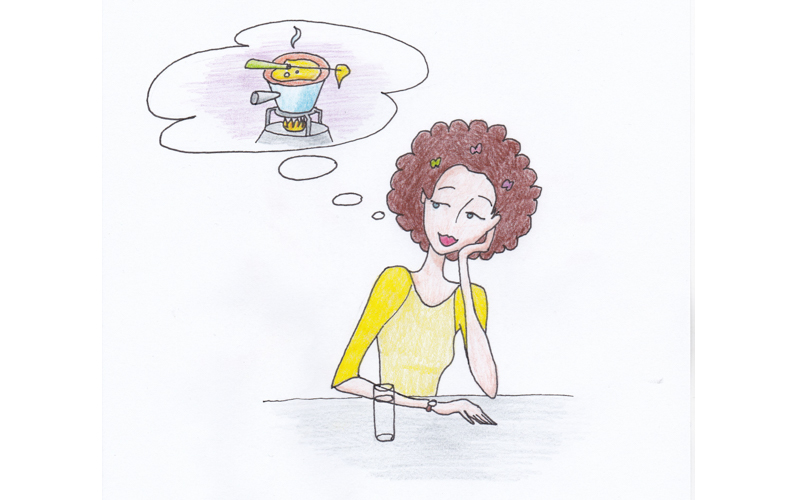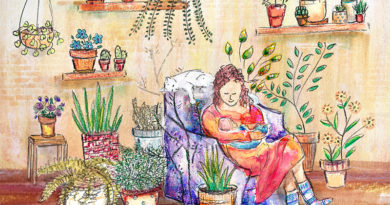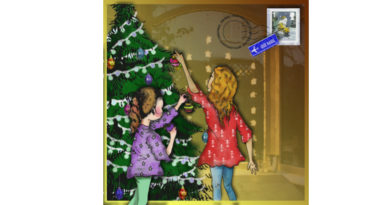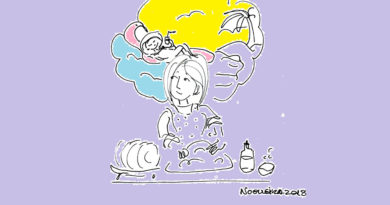Mixing Foods

My sister Sarah loves Marmite. This makes travelling easy, or at least returning from a trip with a gift for Sarah: a jar of Marmite and you’re sorted.
Now, I’ve always said that when it comes to spotting a person’s true nationality (a game I used to play at airports), you can tell where someone comes from, however perfect her accent, by the language she counts in. That has never failed me. I have always believed that food is another giveaway. Don’t we develop tastes in the early years of our childhood? What we get used to is what we learn to love, right? (Consider the joke about the man who receives a burned meal and likes it because it tastes “just like my mother used to make.”)
However, Sarah is Swiss. She’s lived in Switzerland since she was fourteen. Swiss people don’t normally appreciate the dark brown spread on their bread, nor do they warm to the salty flavour or the yeasty smell. So according to my “test,” I’d guess she was English.
Of course there are exceptions to every rule. I’m not sure that all English people love Marmite (“Love it or hate it”), and there may be the odd Swiss person who actually likes its taste. But still, I believe it’s the foods we grew up with that keep our taste buds happy. This, in turn, can make travelling at a young age wonderfully exciting. Children may be fussy eaters, and for parents it’s often quite a task to get them to eat vegetables and healthy foods. On the other hand, given the chance, children will experiment. If exposed to local foods they will try them and maybe even decide to like them. After all there is so much more than just the taste that ties us to the food we crave.
I remember the family fondues we used to eat in our holiday chalet in the Alps by the open fireplace after a day out skiing. I am still looking for a fondue that will taste the same, and I’m sure it’s not just the quality of the mountain cheese.
Sometimes I get out my wooden banana flattener (two wooden boards joined at the tip) and I make Colombian patacones, which are deep-fried green plantains that have been squashed into a form that looks a bit like a pancake. The taste is slightly less sweet than the bananas you normally get here, but I love it for the memory. It brings me back to the summer holidays we spent on the beaches in Cartagena and swimming with dolphins.
My youngest sister Eva just recently made my parents a Peruvian ceviche, which is an amazing dish of marinated fish eaten raw with a lot of onions. We used to eat it at the end of a beach day on the gorgeous playas just north of Lima. My parents’ eyes twinkled when they told me about Eva’s ceviche. And there’s no stopping them when someone finds a bottle of pisco, a Peruvian brandy which, when mixed with limes, syrup and egg white turns into a most treacherous drink that tastes much like lemonade but, in my mum’s words, “Oh my, when you get up, your legs are like jelly.” My parents are not drinkers – not by a long shot (they’re Swiss after all!) – but again, they associate our amazing years living in Peru with the cocktail, so the drink ties them to the past. (And it’s not like my sisters and I don’t have our fair amount of jolly pisco tales, but that’s another story.)
Bringing my kids up in Switzerland makes it hard to introduce all these special foods (not to worry, pisco’s still a well kept secret). Often when my kids impatiently have their first taste of a delicacy from my childhood, their look of disappointment says it all, and “Uuuggh” is often their reaction. I’m not giving up though. They don’t have to like Marmite, but when it comes to Flake (just the bar), well, there are no excuses. It is, after all, a part of their cultural heritage.
By Karin Mohler
Karin has lived between cultures for her entire life and has come to the conclusion that this will always be a big part of her. Having no roots doesn’t bind her anywhere in particular, but she is careful not to impose that sense upon her children, who have been born and bred in Switzerland. She has taken a lot of inspiration for understanding her “in-betweenness” from the book Third Culture Kids: Growing Up Among Worlds, by D. C. Pollock and R. V. Reken (2009).
Illustration by Lara Friedrich
Lara has been a freelance illustrator for Mothering Matters since early 2013. She is in her second year of University where she’s currently working as an assistant in a research project in pedagogy. Lara is also an assistant translator from German to English for various fiction books, as well as being a demo singer for the songwriter Kate Northrop.




Pingback:Karin wants an appletree | Eat, Drink and be Merry